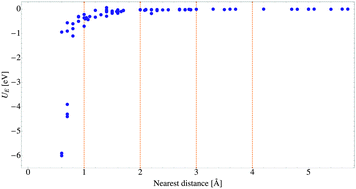Remarks on energetic conditions for positronium formation in non-polar solids. Coupled dipole method application†
Abstract
A numerical program calculating the energy of a positron or/and an electron near the free volume in solid n-alkanes has been built. The theory of the interaction of e+ or/and e− with this non-polar medium based on polarizability has been introduced. The energy of the e+–e− pair in the bulk was compared to that calculated when the pair forms a positronium (Ps) inside the free volume. The calculations are based on the coupled dipole method and the dipole–dipole interaction energy for induced dipoles is taken into account. Furthermore, a correction for the local permittivity for the e+–e− interaction is calculated taking into account the non-isotropic medium between them. The method is a step toward more accurate calculations of energetic conditions during Ps formation in matter. The possibility of the emission of the excess energy of the Ps formation as electromagnetic radiation is discussed. It is argued that if this radiation is observed, it can be used as a new spectroscopic tool providing information about the microscopic properties of media.


 Please wait while we load your content...
Please wait while we load your content...